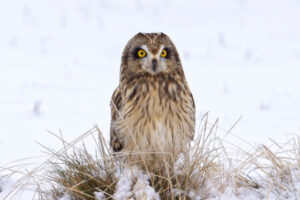With more than 300 avian species, the Adirondack Park is a favorite among bird enthusiasts all year long, but winter offers birders a rare opportunity. After spending much of the year breeding and raising young in the Canadian tundra, several raptors and other birds of prey migrate south to the Adirondacks in the winter to roost and hunt. As a result, many birders flock to the area every winter for a chance to see these birds in the wild.
Here are just a few of the unique raptors and birds of prey you may encounter while birding in the Adirondacks this winter.
Short-Eared Owls
Once one of New York’s most common owls, the short-eared owl is now an endangered species. Similar to barn owls, they have beige round facial disks and brown and white mottled plumage. While they no longer breed in the Adirondacks, short-eared owls continue to winter here and can be found roosting on the ground in large open grassland areas with abundant mice and voles. As the most diurnal species in the Adirondacks, they are most often spotted in the late afternoon, and at dawn or dusk, when they can be seen diving from perches or flying low over the ground in search of prey.
Snowy Owls
These winter raptors are commonly spotted on the lake shores of the Adirondacks and wide-open grasslands, preferring areas that are low and flat with short plants and grasses and an abundance of small prey. The snowy owl has pure white plumage marked by occasional dark spots, large talons, and pointed wings made for speed. With a wing span of approximately 4.5 feet, they are the largest owls in North America. Built to handle the cold weather, the snowy owl is also well insulated, often found sitting on piles of snow to cool off when the temperatures rise.
Rough-Legged Hawks
Another irruptive species from Canada, the rough-legged hawk can be found wintering in the Adirondack Park. These dark-brown, boldly patterned hawks are larger than a crow but slightly smaller than the more common red-tailed hawk. Their “rough legs” are covered in feathers to prevent heat loss in cold environments, and their tails are darker at the tip and lighter at the base. They are often seen perched on fence posts and on the slender branches at the very tops of trees, scanning the ground for lemmings, voles, and other small mammals and birds. When they soar, they raise their wings in a slight V-shape.
Enjoy Bird Watching Year Round With Your Own Piece of Adirondack Land for Sale
If you’re a true avian enthusiast, consider purchasing one of our Adirondack properties for sale. You’ll be able to enjoy spectacular birding in any season, and by owning your own parcel of land you have 24/7 access to backcountry beauty unlike anywhere else in the world. Browse available land parcels or contact us today to set up a visit!


